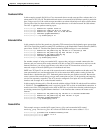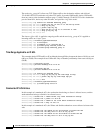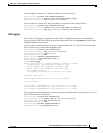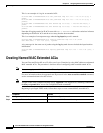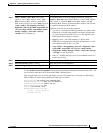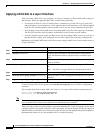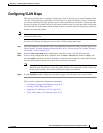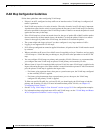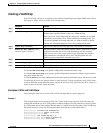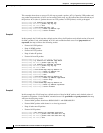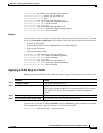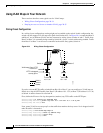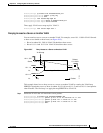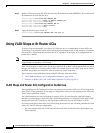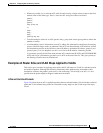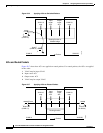
28-31
Cisco ME 3400 Ethernet Access Switch Software Configuration Guide
78-17058-01
Chapter 28 Configuring Network Security with ACLs
Configuring VLAN Maps
Creating a VLAN Map
Each VLAN map consists of an ordered series of entries. Beginning in privileged EXEC mode, follow
these steps to create, add to, or delete a VLAN map entry:
Use the no vlan access-map name global configuration command to delete a map.
Use the no vlan access-map name number global configuration command to delete a single sequence
entry from within the map.
Use the no action access-map configuration command to enforce the default action, which is to forward.
VLAN maps do not use the specific permit or deny keywords. To deny a packet by using VLAN maps,
create an ACL that would match the packet, and set the action to drop. A permit in the ACL counts as a
match. A deny in the ACL means no match.
Examples of ACLs and VLAN Maps
These examples show how to create ACLs and VLAN maps that for specific purposes.
Example 1
This example shows how to create an ACL and a VLAN map to deny a packet. In the first map, any
packets that match the ip1 ACL (TCP packets) would be dropped. You first create the ip1ACL to permit
any TCP packet and no other packets. Because there is a match clause for IP packets in the VLAN map,
the default action is to drop any IP packet that does not match any of the match clauses.
Switch(config)# ip access-list extended ip1
Switch(config-ext-nacl)# permit tcp any any
Switch(config-ext-nacl)# exit
Switch(config)# vlan access-map map_1 10
Switch(config-access-map)# match ip address ip1
Switch(config-access-map)# action drop
Command Purpose
Step 1
configure terminal Enter global configuration mode.
Step 2
vlan access-map name [number] Create a VLAN map, and give it a name and (optionally) a number. The
number is the sequence number of the entry within the map.
When you create VLAN maps with the same name, numbers are assigned
sequentially in increments of 10. When modifying or deleting maps, you
can enter the number of the map entry that you want to modify or delete.
Entering this command changes to access-map configuration mode.
Step 3
action {drop | forward} (Optional) Set the action for the map entry. The default is to forward.
Step 4
match {ip | mac} address {name |
number} [name | number]
Match the packet (using either the IP or MAC address) against one or more
standard or extended access lists. Note that packets are only matched
against access lists of the correct protocol type. IP packets are matched
against standard or extended IP access lists. Non-IP packets are only
matched against named MAC extended access lists.
Step 5
end Return to global configuration mode.
Step 6
show running-config Display the access list configuration.
Step 7
copy running-config startup-config (Optional) Save your entries in the configuration file.



